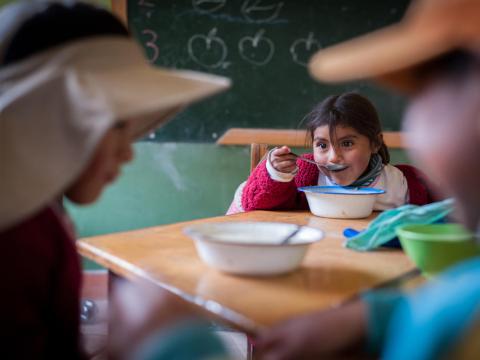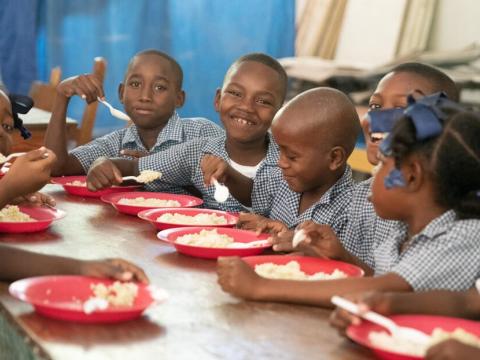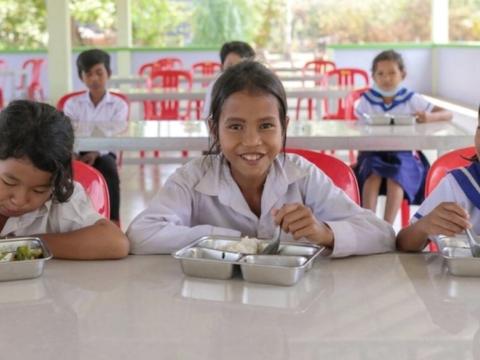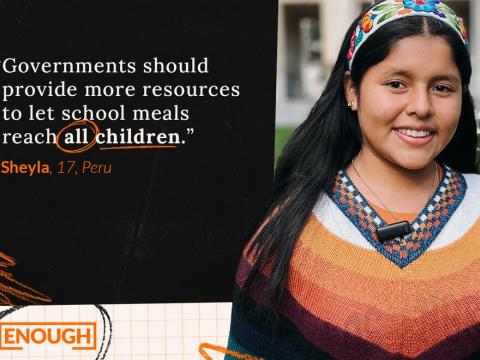
Time to learn 4 important lessons about providing school meals
Serena Stepanovic and Mary Njeri share World Vision insights into school feeding that can make such programming fair and reach everywhere.
11 December, 2024
Providing school meals seem, at first glance, a simple premise: filling hungry tummies so children can focus on their lessons. It’s an approach that we can all relate to—none of us would have survived school without food breaks. The return on investment of governments spending money to feed school children hardly seems like a complicated equation.
But the reality is that only 73% of countries have a national school feeding policy. Having food at school should be a vital public service. Thankfully, over the past 10-15 years, governments around the world have increasingly recognised the importance of school meals as public service for investing in future generations.
A recent report from the World Bank highlights the steady growth in school meals programmes during this timeframe, noting that school meals are likely “…the most extensive [form of] social protection” programming worldwide. Yet, while an estimated 50% of the world’s in-school children receive school meals, this service often covers a greater percentage of children in high income countries when compared to low- and middle-income countries.
School feeding meals programming is sadly neither fair, nor everywhere.
As a leading global partner within school meals programmes, World Vision has identified four key insights that we believe help to expand such programmes and make them more equitable:
Insight #1: Effective school meals programmes are also the product of intentional infrastructure and systems design.
World Vision is committed to catalysing systems-level change within the low- and middle-income countries where we work. School meals programmes also sit at the intersection of agrifood, health and social protection systems, requiring agricultural production inputs and driving towards nutritional and education or social protection outcomes. They provide a potential efficiency in supporting human development goals that focus on the next generation workers and leaders.
Insight #2: Sustainable school meals have immense potential to address climate change and environmental issues, and to support the local economy by incorporating food purchased from small local farmers.
In stable contexts, school meals often include a variety of locally sourced, nutritious foods that support both the health of students and the local economy. For example, in Brazil, the National School Feeding Programme sources a significant portion of its food from local family farms, promoting sustainable agriculture and providing fresh, healthy meals to students. School meals programmes in fragile contexts face additional challenges such as supply chain disruptions and higher levels of food insecurity. Innovative design is critical for addressing constraints in these contexts.
The USDA McGovern-Dole project in Mozambique addressed these constraints by linking local farmer groups to schools, requiring them to contribute 30% of their harvest towards school feeding. This not only ensured a steady supply of food but also supported local agriculture and community engagement. As a result, the project was able to provide daily meals to over 81,000 beneficiaries, including students, teachers, and cooks, significantly improving nutrition and educational outcomes.
Insight # 3: Local leadership are vital in addressing school feeding challenges, promoting sustainable solutions that empower communities to nourish their children’s futures.
Local governments play a crucial role in guiding and supporting school meal efforts. In Mozambique, the government collaborated with World Vision to improve school infrastructure and provide daily meals. A local official noted, "Our commitment to school feeding is not just about providing food; it's about investing in our children's future and building a stronger, healthier nation." The project also involved community health volunteers and local farmers, ensuring a holistic approach to child nutrition and education. This collaborative effort led to significant improvements in school attendance and literacy rates, demonstrating the power of local leadership in driving sustainable change.
Children who benefit from school meals often express profound gratitude and highlight the positive impact on their education and well-being. One student from Kenya shared, "Having a meal at school means I can concentrate better in class and not worry about being hungry. It helps me and my friends stay focused and do well in our studies."
Insight # 4: Strategic global partnerships are essential for scaling school meal operations and impact on child nutrition.
World Vision’s commitment to school feeding is global in nature, reflecting direct partnerships with USDA, WFP, and Education Cannot Wait and leveraging a range of private donor resources. School meals are also a key element within our global campaign, ENOUGH, which aims to end malnutrition and hunger among the world’s most vulnerable children. World Vision currently provides school meals across 20 countries and participate in the School Meals Coalition. Our work in school meals also reflects our commitment to fostering resilience across the Humanitarian-Development -Peace (HDP) nexus. Through these and other partnerships, we are able to leverage collective expertise and resources to create lasting change and ensure every child had access to nutritious food, unlocking their full potential.
Hundreds of millions of children globally are not getting enough healthy food. School feeding is part of the solution for that terrible state of affairs. Let’s do all we can together to ensure the world’s school meals programming get an A++ at the end of 2025.
ENDS
To learn more about World Vision's school meals programming visit here
To learn more about World Vision's engagement in the Global Child Nutrition Forum visit here
Serena Stepanovic is a senior leader with more than 26 years of experience in highly competitive, international development organisations, with work experience in 20 countries. She has provided overall strategic leadership for World Vision's food security and livelihoods sector since 2018. She is a co-author of World Vision United States’ climate action white paper, contributor to FAO’s 2023 report on the Status of Women in Agrifood Systems and lead author for a forthcoming World Bank publication focusing on fostering financial inclusion through resilience efforts.
Mary Njeri is a mentor, humanitarian, advocate and gifted leader, with over 15 years of experience successfully supporting disaster and conflict affected populations in Kenya and Uganda. Known for having excellent humanitarian leadership, people management and program development skills, Mary served as Response Director in the Uganda Refugee Response and am currently the World Vision, Director, Global Hunger Response.



